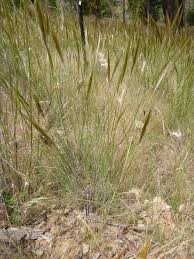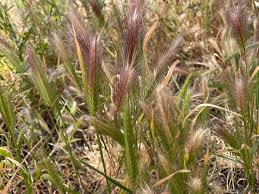Fox Tail Grass, also known by its scientific name Alopecurus pratensis, is a special kind of grass that brings a touch of natural beauty to gardens and open spaces. Imagine a plant that looks like a fluffy fox’s tail waving gently in the wind – that’s exactly what Fox Tail Grass is!
This grass is famous for its unique appearance. It has fluffy spikes that grow close together and look a bit like a fox’s tail. These spikes start off as a soft green color and can change to a golden color as they get older. The grass itself can grow to be anywhere from 1 to 3 feet tall, which is about as tall as a small child.
People really like Fox Tail Grass because it’s not just pretty to look at – it also has some special meanings in different cultures. For a long time, this grass has been used in traditional ceremonies and rituals to show things like good luck, togetherness, and strength. Crafty people have even used its fluffy parts to make decorations that look really nice.
Gardening enthusiasts love using Fox Tail Grass in different ways. Some people like to put it in the middle of a garden bed so that everyone can see its unique look. Others use it to make borders around pathways or separate parts of a garden. When the sun shines on it, the grass looks even more beautiful and catches everyone’s eye.
Taking care of Fox Tail Grass is not very hard. It can grow in many kinds of soil, like clay or loamy soil. Once it gets used to its new home, it doesn’t need a lot of water, which is good news if you sometimes forget to water your plants. Just remember to give it some water when it’s still young, and trim it a bit in the late winter so it can grow strong and pretty in the next season.
But there’s more to this grass than just looks. Fox Tail Grass is like a little hotel for wildlife! Birds really like its seeds, and they come to visit often. So if you have Fox Tail Grass in your garden, you might get some new feathered friends stopping by.
However, Fox Tail Grass is a special kind of plant that adds beauty to the world in its own fluffy way. Whether it’s waving in the breeze or helping out the local birds, this grass shows us that even the simplest things in nature can bring a lot of joy and wonder. So if you’re thinking about adding some charm to your garden, give Fox Tail Grass a try – you won’t be disappointed.
Read Also: A Guide to Growing and Caring for Feather Grass (Needle Grass)
Growing and Care Guide of Fox Tail Grass

Fox Tail Grass, scientifically known as Alopecurus pratensis, is an attractive grass species that can easily enhance the charm of your garden. If you’re considering adding this lovely plant to your outdoor space, here’s a simple guide on how to grow and care for it.
1. Choosing the Right Location: Select a spot in your garden that receives ample sunlight. Fox Tail Grass thrives in areas with full to partial sun exposure. Make sure the soil is well-draining to prevent waterlogging.
2. Planting: Spring or early fall is the best time to plant Fox Tail Grass. Prepare the soil by loosening it and removing any weeds. Gently place the grass plugs or seeds at the recommended depth, which is usually not very deep. Leave enough space between plants to allow them room to grow.
3. Watering: When your Fox Tail Grass is newly planted, it needs consistent moisture to establish its roots. Water the grass regularly for the first few weeks. Once it’s established, it becomes more drought-tolerant and requires less frequent watering. Avoid overwatering, as this can lead to root rot.
4. Fertilizing: A balanced, slow-release fertilizer can be applied during the growing season to provide essential nutrients. Follow the instructions on the fertilizer packaging for the appropriate application rate. Over-fertilizing can lead to excessive growth and reduce the aesthetic appeal of the grass.
5. Pruning: In late winter or early spring, trim back the grass to about 2 to 3 inches above the ground. This helps rejuvenate the plant and encourages healthy new growth. Remove any dead or damaged leaves throughout the year to keep the grass looking tidy.
6. Pest and Disease Management: Fox Tail Grass is relatively resistant to pests and diseases. However, keeping an eye out for any signs of damage or disease, such as discoloration or unusual growth patterns, is essential. Promptly address any issues by taking appropriate measures, which may include using natural remedies or seeking professional advice.
7. Wildlife Benefits: The plumes of Fox Tail Grass are not only visually appealing but also provide a food source for birds. As the grass matures, its seeds become available to local bird populations, attracting them to your garden and supporting biodiversity.
8. Winter Care: Fox Tail Grass is hardy in many climates, but some varieties may benefit from a layer of mulch to protect the roots during cold winters. This is especially important if you’re growing the grass in colder zones.
9. Propagation: If you wish to propagate Fox Tail Grass, you can divide mature clumps in early spring. Carefully dig up the clump and separate it into smaller sections, each containing roots and shoots. Replant these divisions in well-prepared soil.
By following these simple steps, you can enjoy the beauty of Fox Tail Grass in your garden. Its graceful appearance and low-maintenance nature make it a fantastic choice for both novice and experienced gardeners. With a little care and attention, your Fox Tail Grass will flourish and add a touch of elegance to your outdoor space.
Read Also: A Guide to Growing and Caring for Poa Annua Grass
Benefits of Fox Tail Grass

Here are some benefits of Fox Tail Grass (Alopecurus pratensis) that you can explore:
1. Aesthetic Enhancement: Fox Tail Grass adds a touch of elegance and visual interest to landscapes and gardens with its unique and graceful appearance. The feathery spikes resemble a fox’s tail and create a soft, wispy texture that contrasts beautifully with other plants.
2. Low-Maintenance Landscaping: This grass is known for its easy-care nature. Once established, it requires minimal maintenance, making it an ideal choice for busy homeowners or those new to gardening.
3. Adaptable to Various Environments: Fox Tail Grass can grow in a range of soil types and is relatively versatile when it comes to sun exposure. It can adapt to both full sun and partial shade, providing flexibility in garden design.
4. Erosion Control: Its dense root system helps stabilize soil and prevent erosion, making it a valuable addition to gardens on slopes or in areas prone to soil runoff.
5. Wildlife Attraction: The seeds produced by Fox Tail Grass are a food source for various bird species. By cultivating this grass, you can attract birds to your garden, contributing to local biodiversity.
6. Drought Tolerance: Once established, Fox Tail Grass displays good drought tolerance. This quality makes it suitable for regions with inconsistent rainfall or for gardeners looking to conserve water.
7. Seasonal Interest: As the grass matures, its plumes change color, transitioning from soft green to golden hues. This dynamic feature adds seasonal interest and diversity to your garden.
8. Natural Movement and Sound: The swaying movement of the feathery plumes in the wind adds a sense of life and movement to the garden. The gentle rustling sound created by the grass adds to the overall sensory experience.
9. Cultural and Symbolic Significance: Fox Tail Grass has been used in various cultures for its symbolic meanings, representing qualities like unity, prosperity, and strength. Incorporating it into your garden can connect you to these traditions.
10. Pollinator Support: While primarily known for its appeal to birds, Fox Tail Grass can also attract pollinators such as butterflies and bees, contributing to the pollination of other plants in your garden.
11. Natural Privacy Screen: The height and dense growth of Fox Tail Grass can serve as a natural screen or divider within your garden, providing a degree of privacy or visual separation.
12. Craft and Decorative Uses: The plumes of Fox Tail Grass can be harvested and used in decorative arrangements, wreaths, and crafts, allowing you to bring a touch of nature indoors.
Incorporating Fox Tail Grass into your landscape offers a range of benefits that extend beyond its visual appeal. Whether you’re looking for an easy-care plant, a way to attract wildlife, or a meaningful addition to your garden, Fox Tail Grass has something to offer.
Read Also: E-Waste Recycling Equipment: The Key to a Greener Future
